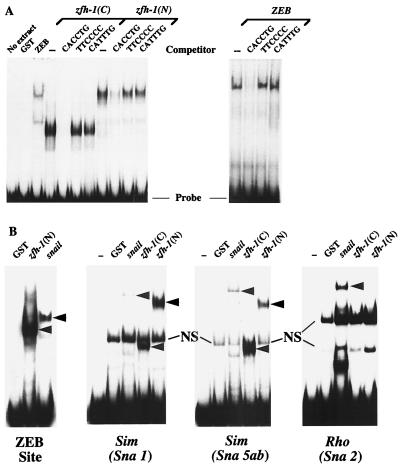FIG. 1.
zfh-1 binds E box sequences. (A) Gel retardation assays using a probe containing CACCTG sites (36). Recombinant proteins encoding the C- and N-terminal zinc fingers of zfh-1 [zfh-1(C) and zfh-1(N), respectively] and N-terminal zinc fingers of ZEB were obtained from overexpression in bacteria as described in Materials and Methods. zfh-1 and ZEB binding was competed with a 50-fold excess of unlabeled probe but not with the mutant non-E box probe (TTCCCC) or an unrelated E box sequence (CATTTG). (B) Snail and zfh-1 share DNA binding specificities. A probe containing a ZEB binding site (E361/E399 in the α4 integrin promoter [36]), the highest-affinity sites for snail from the single-minded (sim) promoter (Sna1 and Sna5b as in reference 23) and from the rhomboid promoter (Sna2 as in reference 22) were used in gel shift experiments to test the binding of GST-snail and GST–N- and C-terminal zfh-1 zinc fingers [zfh-1(N) and zfh-1(C), respectively]. Equal molar amounts of GST fusion proteins (as determined by Western blotting with anti-GST antibodies [data not shown]) were used. Note that zfh-1 binds to snail sites in the single-minded promoter (even to the highest-affinity site, Sna5ab [23]) with even higher affinity than snail. However, binding of zfh-1 to the snail sites in the rhomboid promoter were weak or neglible (this figure and data not shown). Arrowheads indicate specific complex; NS denotes a nonspecific band. Free probes are indicated at the bottom.

